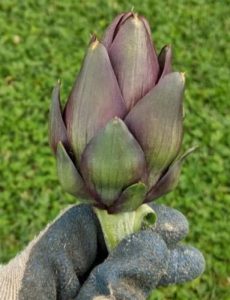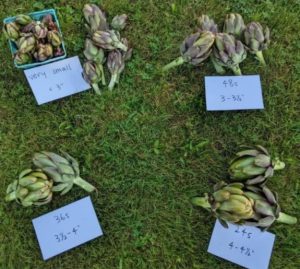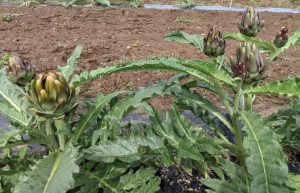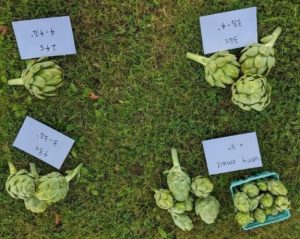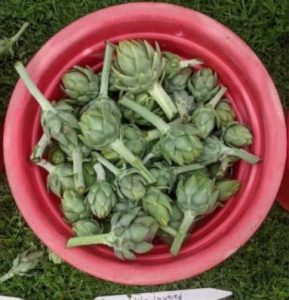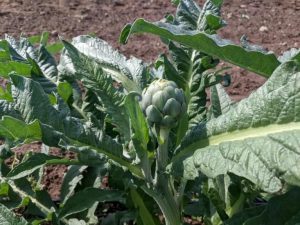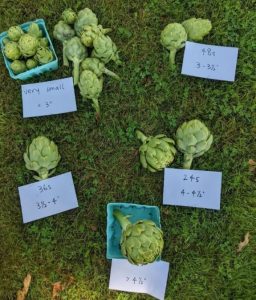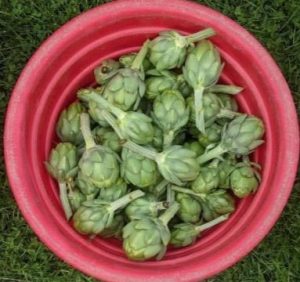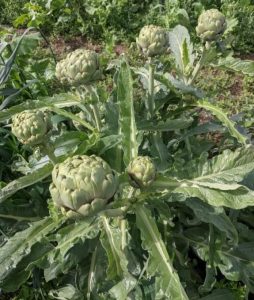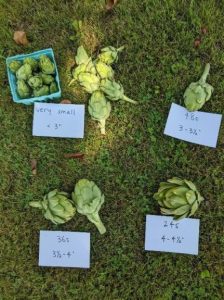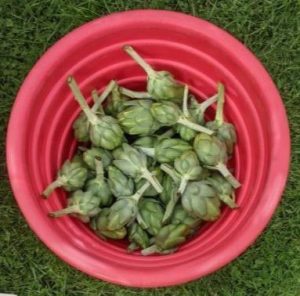Artichokes for the Northeast: 2021 Data
Peyton Ginakes, University of Maine Cooperative Extension Research Associate
Mark Hutton, University of Maine Cooperative Extension Vegetable Specialist
David Handley, University of Maine Cooperative Extension Small Fruit and Vegetable Specialist
Globe artichokes (Cynara cardunculus var. scolymus) are native to the Mediterranean region, which continues to dominate production globally. Monterey County, California produces the vast majority of US-grown artichokes. However, pockets of commercial artichoke production are developing in Texas and other regions. In Maine and New England, artichokes can be found on farm stands and in backyard gardens.
Artichokes are perennial plants and members of the Asteraceae family, which also includes lettuce, thistles, chicories, and sunflowers. They are not reliably winter hardy in Maine and are instead grown as annuals from seed. In order to produce buds in their first year, artichoke seedlings must undergo vernalization (exposure to cold temperatures). The harvestable component of artichokes are buds that, if left unharvested, will mature into vibrant purple inflorescences. Properly vernalized plants commonly produce 10-20 buds per plant, and occasionally more than this. However, only several buds per plant will be “primary” buds, which typically are large enough in diameter to market individually. Buds that form at plant axials further down on the plant are “secondary” buds, which are edible but smaller in size. The smaller buds comprise the majority of buds that a plant produces.
Seedling Production
In 2021, five globe artichoke cultivars were grown at the University of Maine’s Highmoor Farm in Monmouth, ME. Cultivars included Colorado Star, Green Globe Improved, Imperial Star, Tavor, and Wonder. Artichokes were seeded on March 22. Two or three seeds were placed into 50-cell trays filled with Coast of Maine Bar Harbor Blend media. Trays were maintained on heated mats at 75-80 °F until seeds germinated, and then mat temperature was lowered to 65-70° F. Trays were moved off heating mats 3 weeks after seeding.
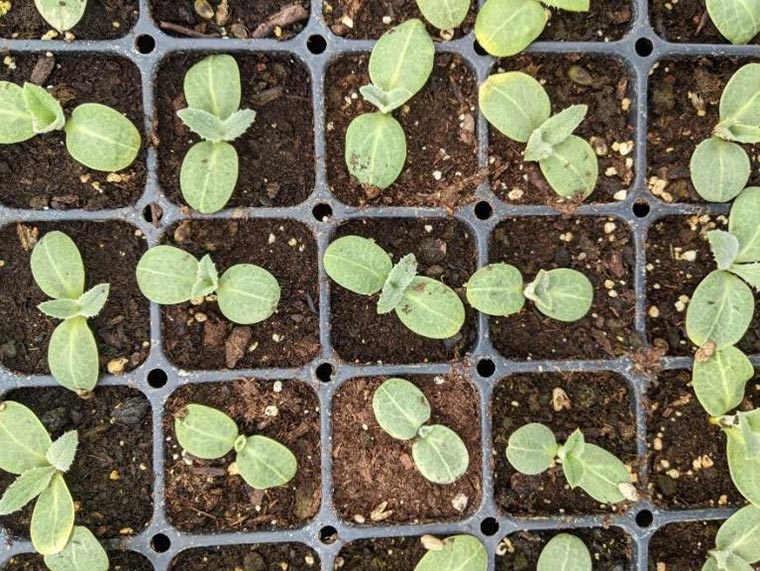
In 2021, five globe artichoke cultivars were grown at the University of Maine’s Highmoor Farm in Monmouth, ME. Cultivars included Colorado Star, Green Globe Improved, Imperial Star, Tavor, and Wonder (see Table 1 for details). Artichokes were seeded March 22. Two or three seeds were placed into 50-cell trays filled with Coast of Maine Bar Harbor Blend media. Trays were maintained on heated mats at 75-80 °F until seeds germinated, and then mat temperature was lowered to 65-70 °F. Trays were moved off heating mats 3 weeks after seeding.
Artichokes vary in their chill requirements, with most cultivars needing exposure to 250-500 hours below 50 °F. The recommended vernalization process for annual production involves exposing 4-6 leaf seedlings (approximately 6-8 weeks old) to an environment that is 45-50 °F for at least 10 days. Many growers and researchers simply transplant artichokes early in the spring, relying on sufficiently cool temperatures to meet the chill requirements. While in many cases this can be successful, the process of vernalizing plants in coolers is not labor- or space-intensive, and has the greatest chance of uniformly meeting chill requirements.
In this experiment, seedling trays were placed into a 40 °F walk-in cooler on May 10, for 14 days prior to transplanting. Seedlings were thoroughly watered before vernalization, and afterward were watered with Peter’s 20-20-20 (1 Tbsp per gallon) water soluble fertilizer.
Bed Preparation and Transplanting
Beds were prepared three days before transplanting by spreading 500 lb per acre of 10-10-10 fertilizer ahead of rototilling and forming raised beds with a single drip line. Three mulch systems were evaluated: straw mulch, black plastic, and bare ground. We hypothesized that 1) a straw mulch would mediate hot summer soil temperatures and reduce weed pressure, 2) black plastic would suppress weeds, but that elevated soil temperatures would affect yield, and 3) the bare ground treatment would not warm the soil but could allow for increased weed pressure.
The trial was transplanted on May 24 in a split-plot design, using mulch as the main plots and cultivar as the subplots, with four replicated blocks. Therefore, each block had one bed of each mulch treatment, within which there were five cultivar subplots. Plots consisted of 12 plants with end plants used as guards. Data were collected from the center ten plants of each plot. Seedlings were transplanted using a jab transplanter in single rows at 24” in-row spacings. Transplants were watered with Nutriculture Spoon-Feeding Soluble Fertilizer (12-45-10) at a rate of 3 lb per 50 gallons water. Straw mulch was applied June 15.
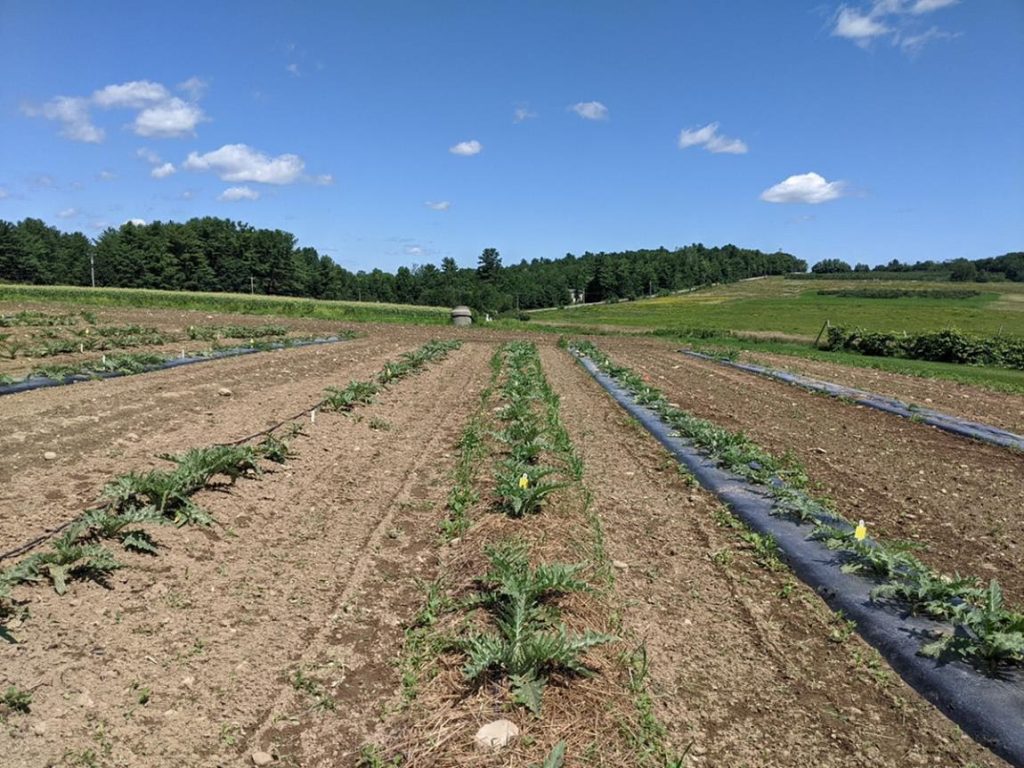
Growing Conditions
The 2021 growing season can be characterized as changeable. The spring and early summer were warm and dry, while the fall was warm and wet. July was unusually wet and cool, while weather in August was more typical for this region.
Observed Pests and Diseases
Several insect pests negatively impacted artichoke production. Aphids, primarily green peach aphid, fed on lower leaves, likely slowing growth early in the season. Additionally, thrips caused twisting and curling of leaves and, to a lesser extent, some buds. Tarnished plant bug was observed later in the season. Applications of Asana XL were made on July 23, August 8, and September 8. Gray mold (Botrytis cinerea) was the only identified pathogen in this trial, and caused only a minimal loss of buds.
Harvest
Artichoke harvest began August 20 and was continued weekly until September 17. A final harvest was made October 1. To assess whether artichokes were ready for harvest (ie, fully sized), buds were squeezed to assess how densely packed the bracts were. Buds were harvested by clipping with 1-2” of stem using hand pruners. Buds were sorted into USDA size classes: 48s (3-3.5”), 36s (3.5-4”), 24s (4-4.5”) and 18s (>4.5”). Buds smaller than 48s were categorized as “very small”. Plants continued to produce high-quality buds, mostly secondaries, with some frost injury (dark spots on bracts) through light frosts until a hard freeze killed plants.
Results
Transplant survival
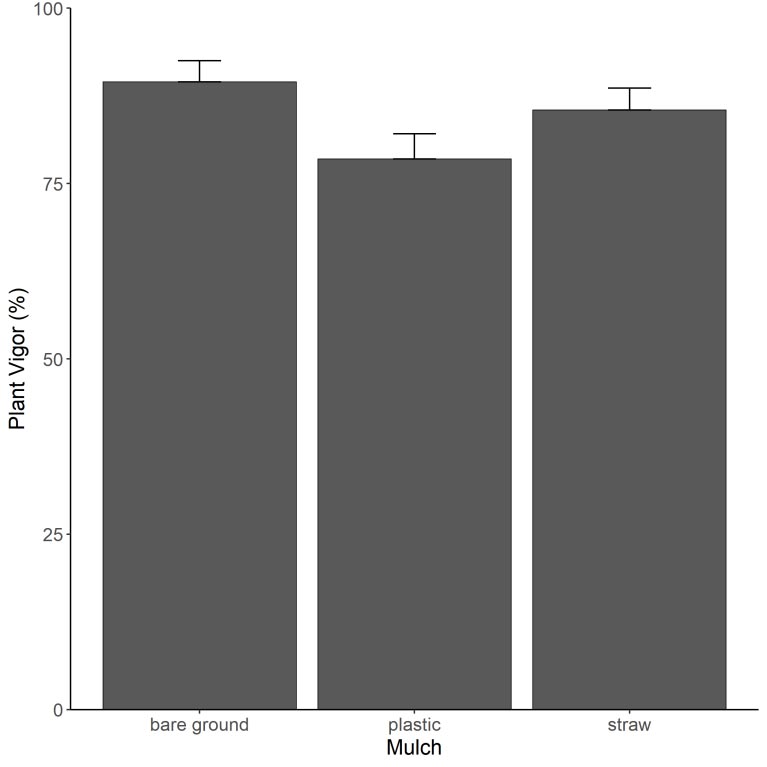
The number of living plants in each plot two weeks after transplanting were recorded. Bare ground had the greatest plant survival followed by straw mulch and plastic mulched plots (Figure 3), although differences were not statistically significant. However, there was an 11.5% decrease in plant survival observed on black plastic mulch compared to bare ground. Temperatures were very high at the time of transplanting, and plant loss is thought to be related to heat stress. Transplanting under cooler conditions and irrigation are recommended for mitigating heat stress.
Yield Ranges
The sum of marketable yields over the season varied by variety, from single plants producing an average of about 1.0 to 1.6 lb and a maximum of about 3.3 to 4.8 lb (Table 3). Varieties with maximum yield potential are Green Globe Improved, followed by Tavor.
Vernalization
Success of vernalization was measured as the number of plants producing buds in each plot. Marketable buds were produced on 50% to 96% of plants (Table 4). When grown on black plastic, Tavor and Wonder plants did not produce buds as reliably as Colorado Star or Green Globe Improved. This may indicate that the chilling requirement was not fully met for these two cultivars, that some seedlings were not at the proper developmental stage to respond to the vernalization treatment, or that these cultivars have greater potential for devernalization responses to high temperatures.
Marketable Yield
Yield data are shown in Table 4 as both the number and weight of buds. Buds under 3” in diameter could be sold either way, and are suitably sized for quart containers or similar, depending on one’s market. Any buds that fit into USDA size classes could likely be sold individually. These size classes are summed in the table below and are categorized as “large”.
Green Globe Improved produced more marketable buds in total than Colorado Star by nearly double (Table 4), as well as more buds in the very small size category than either Colorado Star or Imperial Star. Across size classes, Tavor and Imperial Star were mid-level performers that we found to be more attractive than Green Globe Improved (see next section for descriptions).
Bare ground production appeared to be especially favorable for large bud production. Across all cultivars, artichokes grown on bare ground produced a greater number of large buds than those grown with straw mulch. Specific to Tavor and Wonder, bare ground production also increased total large bud weight relative to black plastic and straw mulch, respectively. In this growing system, Tavor outyielded Green Globe Improved in total large bud weight.
The yield increase of artichokes grown on bare ground is probably due to cooler soil temperatures. While soil temperatures in the straw mulch treatment were moderated by the straw (data not shown), the mulch itself became a weed issue. Clearing weeds from under the straw mat was difficult and often ineffective, whereas plants on bare ground were easier to keep free of major weed competition.
Small versus Large Bud Production
The proportion of total buds that were large enough to be marketed individually (> 3” diameter) was not statistically different across mulches or cultivars (Table 5).
Visual Observations
Colorado Star:
- Purple color dependent on cool temperature; early buds ranged in color from light purple to almost bronze
- Bud shape somewhat pointed and fairly consistent
- Bracts very pointed and spiny
- Bracts often tough/leathery
Imperial Star:
- Vigorous plants
- Fairly consistent bud shape within size classes; less consistent across size classes
- Smaller buds fairly compact but less so at larger sizes
- Fairly spiny bracts
Green Globe Improved:
- Vigorous plants, similar in stature to Imperial Star
- Inconsistent bud and bract shapes
- Occasional purpling at bract bases
- Tended to be less compact
- Fairly spiny bracts
Tavor:
- Vigorous plants
- Compact buds, consistently shaped in all size classes
- Rounded buds and bracts
- Few spines
Wonder:
- Bud shape varied from vase-like to conical
- Bracts were medium-compact
- Produced well until hard freeze (like Imperial Star and Tavor)
- Spineless
Acknowledgments
This work was supported by the University of Maine Agricultural and Forestry Experiment station, Hatch ME021812, and the Maine Vegetable and Small Fruit Growers Association. High Mowing Seeds and Coast of Maine generously donated materials for this project. We are grateful for assistance from David Handley, Greg Koller, Patricia McManus, and Pete Lugner, as well as field assistants Ethan Handley, Lydia Handley, Lee Lavoie, Brooke Martin, and Taylor Truman.
For any questions or comments on this research, please contact Peyton Ginakes at peyton.ginakes@maine.edu or Mark Hutton at mark.hutton@maine.edu or 207.933.2100.
Download and Print:
Information on this website is provided purely for educational purposes. No responsibility is assumed for any problems associated with the use of products or services mentioned in this website. No endorsement of products or companies is intended, nor is criticism of unnamed products or companies implied.
In complying with the letter and spirit of applicable laws and pursuing its own goals of diversity, the University of Maine System does not discriminate on the grounds of race, color, religion, sex, sexual orientation, transgender status, gender, gender identity or expression, ethnicity, national origin, citizenship status, familial status, ancestry, age, disability physical or mental, genetic information, or veterans or military status in employment, education, and all other programs and activities. The University provides reasonable accommodations to qualified individuals with disabilities upon request. The following person has been designated to handle inquiries regarding non-discrimination policies: Director of Equal Opportunity, 101 Boudreau Hall, University of Maine, Orono, ME 04469-5754, 207.581.1226, TTY 711 (Maine Relay System).

